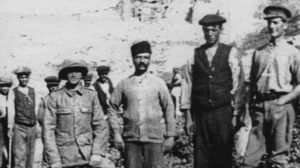Wednesday, Dec 26th, 1917
Reveille 5. Nice morning. Usual routine. 400 Maltese men come on board, a Labour Company. Slept on mess deck floor. Awfully crowded & bad smells. Still in Malta Harbour.
Labour Corps
Since the early days of the Salonika front, the creation of basic infrastructure to support the Allies, such as piers, roads and railways, had been a challenge. This need for infrastructure was echoed in all the theatres of war. Originally each Infantry Division in the British Army had a battalion that, while trained for fighting, would be engaged primarily in labouring work. These were called the Pioneer Battalions. When this proved insufficient to meet requirements, the Labour Corps was formed in January 1917 and comprised men from across India, South Africa, Egypt and the rest of the Empire.¹

Over the course of the First World War, over 5,500 islanders served with the Maltese Labour Corps as non-combatants in support of the Allies. They were employed on three or six month contracts with the option to re-engage and the pay was comparatively good. In early 1915, the first 864 recruits were deployed to Gallipoli and Mudros, a major staging post on Lemnos. They were withdrawn at the end of 1915 from Gallipoli and from Mudros in February 1916.²³
In Autumn 1916, a further group of 900 Maltese labourers and stevedores was raised. This re-formed First Battalion of the Maltese Labour Corps went to Salonika in October to work on the Lines of Communication – linking the front line to its supply bases. A Second Battalion was raised in December 1917. It is possible that the Labour Company which joined Frank on the HMS Kashmir and slept on the mess deck floor was part of this Battalion.²³
References & Further Reading
¹ ‘The Labour Corps of 1917-1918‘ in the Long Long Trail
² ‘Maltese Labour Corps during WWI‘ in The Times of Malta
³ ‘The Maltese Labour Corps during World War I’ by Prof. Albert Caruana and William Zammit PhD, University of Malta
* The Times of Malta, image may be subject to copyright


